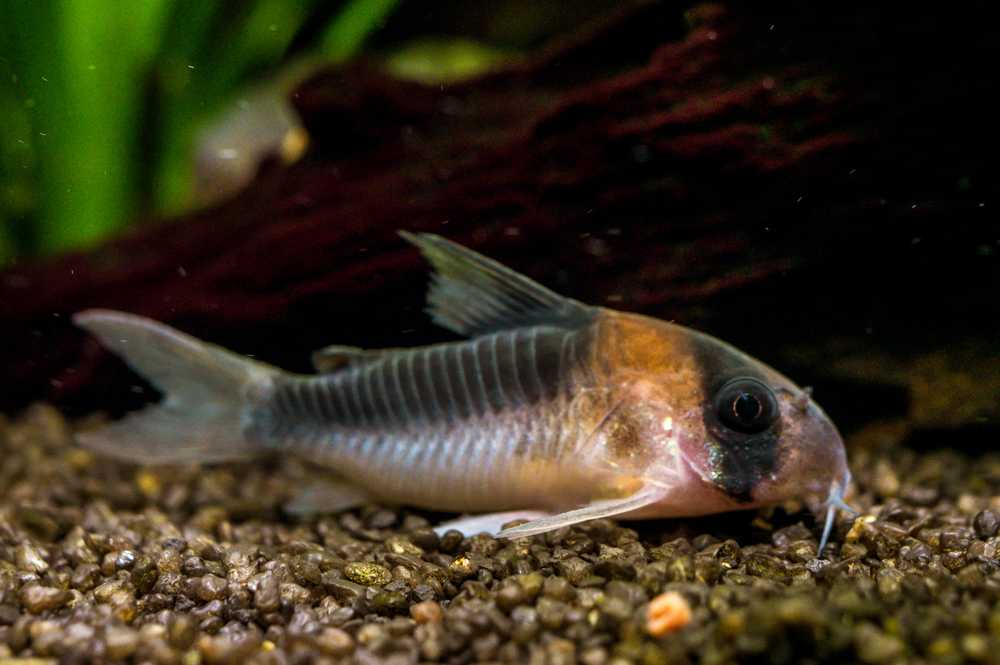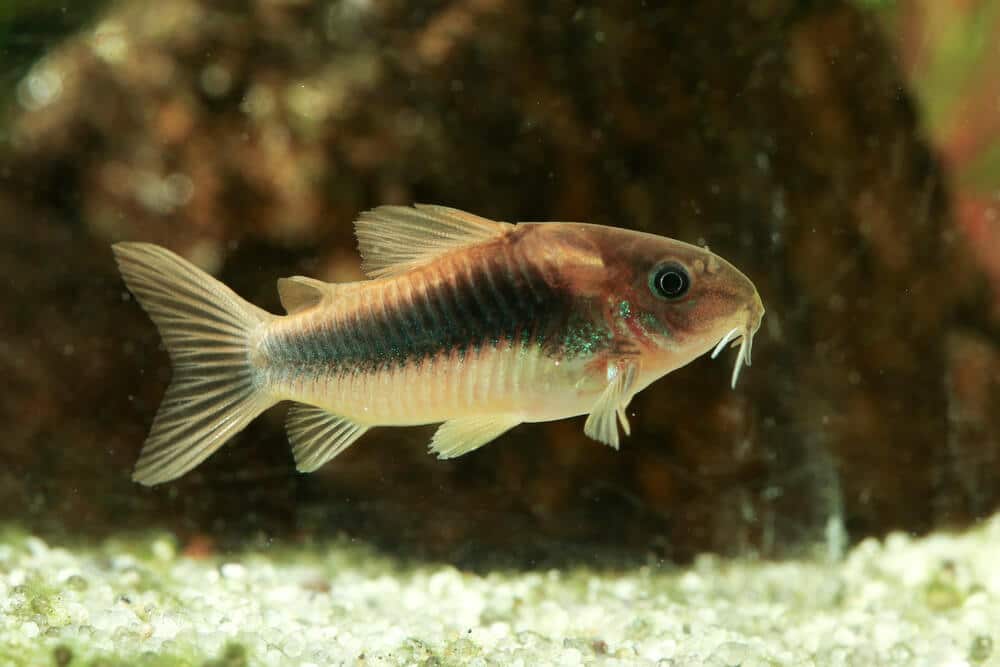There are several cory catfish types available, all of which are easy to care for. That’s why they’re a go-to choice for beginners or hobbyists. Besides, their peaceful temperament makes them excellent tank mates for most fish species.
Not to mention how corys, with their gorgeous colors and patterns, can instantly add a one-of-a-kind flair to the aquarium!
Whether you’re intentionally breeding them or not, knowing the signs of a gravid female will help you prepare for her spawns. So, continue reading to find out how to tell if cory catfish is pregnant and to learn more about its breeding cycle!

Signs That Tell Cory Catfish Is Pregnant
To begin, cory catfish are egg-layers, which means they lay eggs rather than give birth to fry, as livebearers do.
The gravid spot is a common sign of pregnancy in most live-bearing females, making it easy to identify them. Simply put, it’s a dark spot that appears near the base of the anal fin.
Contrary to popular belief, this physical feature is only found in live-bearing fish and doesn’t appear in egg-laying types. So, how can you tell if your cory catfish is gravid? Look for the following three indicators:
1. Appears Plump
Generally speaking, egg-laying fish form eggs in their ovaries before releasing them through the urogenital opening. Thus, if your cory is gravid, she’ll be rounder than usual, indicating the development of eggs.
2. Prefers Isolation
Corys are naturally shy and calm creatures. However, when this tropical fish is carrying eggs, she’ll exhibit increased signs of solitude. You’ll notice that she prefers to swim or stay in the tank’s empty areas. In fact, you might notice her hiding a lot.
3. Increased Male Attention
As spawning time approaches, the male cory becomes unusually interested in the female. He’ll start chasing her around, and you might see both of them doing some frantic dance moves!
Moreover, if you saw them both making a T shape at any point, your female cory is almost certainly carrying eggs. This action shows that the eggs are in the process of fertilization.
When the female moves toward the male’s abdomen, forming a T position, she’s taking his sperm to fertilize the eggs.
How Many Eggs Do Cory Catfish Lay?
Although lots of egg-laying fish spawn a large number of eggs during a breeding session, the cory catfish isn’t one of them. For example, the stunning goldfish can lay about 1,000 eggs from a single breeding! On the other hand, cory catfish release from 10 to 20 eggs at a time.
The good news is, you won’t have any trouble finding your cory’s eggs because she’ll leave them in a pretty visible spot. To be more specific, she’ll stick them on any flat surface, such as the tank’s glass, filter, decorative pieces, etc.
When the female’s ready to lay her eggs, you’ll notice her circling the tank, searching for the ideal place to release her eggs. Once she finds it, she’ll stay there while laying the eggs; the eggs are quite sticky, so they’ll adhere quickly to the surface.
How Often Do Cory Catfish Lay Eggs?
The frequency with which cory catfish lay eggs is influenced by several factors. These factors primarily concern breeding conditions such as diet, water parameters, and so on.
Assuming all breeding requirements are met, your cory should spawn once per week.
We’ll show you in just a moment the perfect breeding conditions for this bottom-dwelling species!
How To Know If Cory Catfish Eggs Are Fertilized?

Let’s now show you how to tell the difference between fertilized and unfertilized eggs.
Unfertilized eggs of a cory catfish will be white or translucent, with no markings. Whereas, two characteristics identify fertilized eggs:
- Being beige in color
- The appearance of a small dark spot near the time of hatching
Keep an eye out for any signs of fungus infection on the eggs. Unfortunately, this is a common occurrence and a major problem for breeders. To explain, there’s a fungus known as Saprolegnia spp. that attaches to fish eggs and kills them before they hatch.
The easiest way for this fungus to obtain food is through egg yolk, so it preys on spawns. The infection usually appears as white fuzzy particles growing on the egg’s surface. The problem is that this infection spreads throughout the surrounding eggs, potentially killing them all.
Unfertilized eggs are especially vulnerable to this type of infection. Consequently, once you’ve identified unsuccessful spawns, it’s best to remove them from the tank.
When Do Cory Catfish Eggs Hatch?
A cory catfish’s fertilized eggs should hatch anywhere from 3 to 6 days after being released. If a week has passed and an egg hasn’t hatched, it was most likely not fertilized.
Super small fry will come out of the hatched eggs. You won’t need to feed them for the first 2 to 3 days because they’ll be feeding on their egg sack. When they’re able to swim, they’ll be ready to consume fry food before they can feed on adult fish food.
Tips For Breeding Cory Catfish And Caring For the Eggs
Luckily, this gorgeous fish is one of the easiest species to breed. Having said that, there are five key tips for healthy and successful breeding; take a look:
1. Setup the Breeding Tank
First off, in addition to your primary fish tank, it’s preferable to dedicate a separate tank solely for breeding. The only difference between a breeding tank and a regular tank is that you won’t need to add any plants or decorations to it.
After that, prepare the tank to accommodate your cory. As you may know, the tank should primarily mimic their natural habitat so that they feel more at ease in it.
You should check the specific preferred conditions for the type of cory catfish you have, but they generally thrive in:
- Substrate: Soft sand
- Temperature: 72 – 82°F
- Water hardness (KH): 3 – 10 DH
- pH level: 7.0 – 7.8
Related Read: Are Cory Catfish A Hardy Fish?
2. Choose a Sexually Mature Trio
Make sure you have sexually mature corys before beginning the breeding process. That way, you won’t waste effort, and stress out your fish by constantly encouraging them to mate when they can’t.
Cory catfish reach sexual maturity at around 9-12 months of age. However, this varies from one species to another.
To increase the chances of a faster breeding cycle, it’s best to pair one female with two males. If you’re not sure how to tell a female cory from a male, examine three features:
- Body contour
- Size
- Fin shape
Female corys are typically longer, wider, and plumper than males, especially around the pelvic fin area. Moreover, male corys’ pelvic and anal fins are usually more pointed than females’.
It’s important to note that these differences can vary between species, so be sure to look up the type you have for more precise sexing signs.
3. Encourage Mating
Two tricks proved their success to encourage cory catfish to mate. The first is to start feeding them live food, such as insects, brine shrimps, and bloodworms. This type of food is high in protein, so it significantly helps in getting their bodies ready for mating.
After a couple of days of feeding your fish live food, gradually reduce the water temperature. Continue to reduce it until it’s three degrees colder than their original tank.
4. Separate the Parents and Eggs
When the mama fish has successfully spawned, remove all of the adult fish from the tank. Cory catfish, like most fish, can consume their eggs.
Many theories have been proposed to explain this phenomenon. One of them demonstrated that fish will sometimes do this to get rid of damaged eggs. Another proved that male fish can eat spawn to compensate for a lack of energy or food.
In any case, separating the eggs from the parents is the best way to ensure their safety. Just remember to bring the tank’s temperature back to normal afterward.
On a side note, if you’re going to transfer the eggs instead, be extra cautious.
Gently detach the eggs from the surface with a razor or your finger and place them in a small container. Make sure they’re not exposed to air while being transferred.
5. Use Fungus Treatment
Fish eggs are susceptible to fungal and bacterial infections, both of which are fatal to them. Fortunately, there are multiple treatments available that can be added to water to keep these infections at bay. Here are a few of the most effective:
- Methylene blue
- Hydrogen peroxide
- eSHa 2000
Along with applying these treatments, you should change the water in the tank every day. If you’re not using a treatment, you should increase the frequency of water changes to at least three times per day.
As previously mentioned, removing unfertilized eggs from the tank can reduce the likelihood of fungus growth.
Wrapping Up
Alright, so you have learned how to tell if a cory catfish is pregnant! You also know how to recognize every stage of its breeding cycle.
If you’re currently breeding this fantastic species, make sure to follow the tips outlined in this article to ensure that the majority of the eggs hatch into healthy fry.
Here’s a final tip: once the fry is ready to eat, feed them live food to encourage faster growth!
Hi! I’m Praveen Ghoshal, the founder of eFishkeeping.com. Inspired by my Dad, I got interested in fishkeeping when I was a kid. Since then, I have been involved with this hobby. Currently, I have 3 fish tanks at our home, and I enjoy this hobby with my full family. Read more about me here.







![Do Neon Tetras Die Easily? [Here’s The Truth!] do-neon-tetras-die-easily](https://efishkeeping.com/wp-content/uploads/2023/03/do-neon-tetras-die-easily-300x200.jpg)